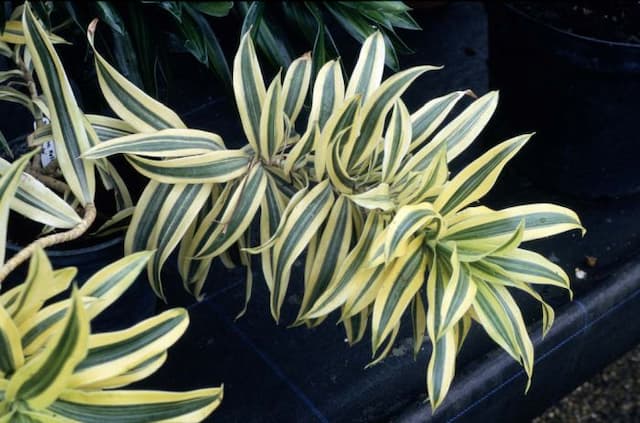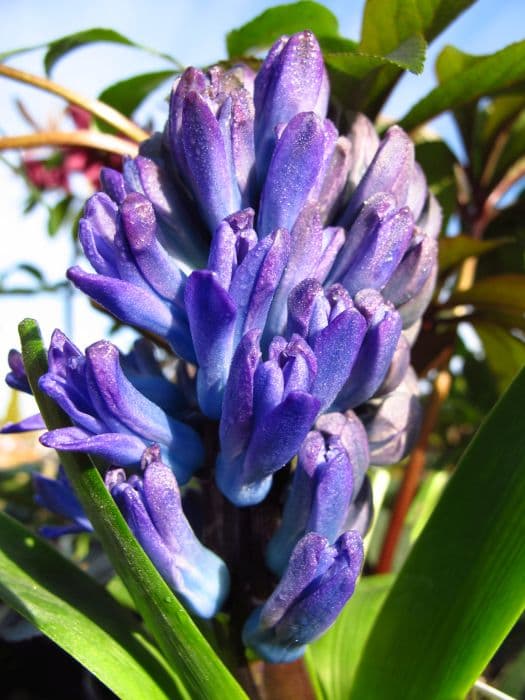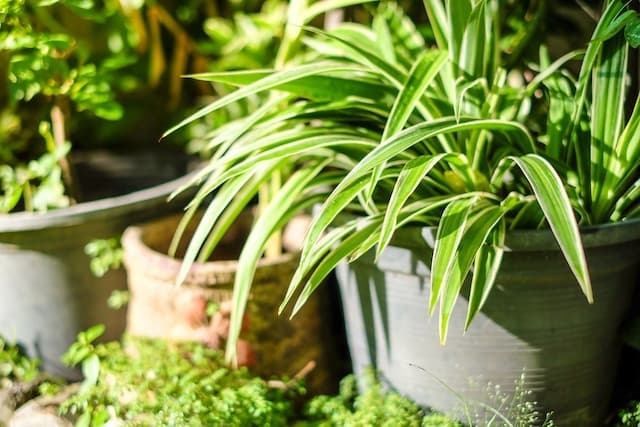Snake plant Sansevieria trifasciata



ABOUT
It is an evergreen perennial plant forming dense stands, spreading by way of its creeping rhizome, which is sometimes above ground, sometimes underground. Its stiff leaves grow vertically from a basal rosette. Mature leaves are dark green with light gray-green cross-banding and usually range from 2.3-3.0 feet long and 2.0-2.4 inches wide, though it can reach heights above 6 feet in perfect conditions. The specific epithet trifasciata means "three bundles".
The plant exchanges oxygen and carbon dioxide using the crassulacean acid metabolism process, which allows them to withstand drought. The microscopic pores on the plant's leaves, called the stomata and used to exchange gases, are only opened at night to prevent water from escaping via evaporation in the hot sun.
It is considered a weed in some areas of northern Australia.
About this plant
 Names
NamesFamily
Asparagaceae
Synonyms
Snake plant, Mother-in-law's tongue, Saint George's sword, Viper's bowstring hemp
Common names
Sansevieria aureovariegata, Sansevieria jacquinii, Sansevieria laurentii, Sansevieria trifasciata
 Toxicity
ToxicityTo humans
Mildly toxic. Their leaves contain a poison that can cause swelling and numbness of the tongue if consumed in high doses. The juice of the plant can cause dermatitis in people prone to allergies.
Chewing or swallowing any part of this plant puts a person at risk of developing a severe allergic reaction, which leads to swelling of tissues in the mouth and esophagus.
If you suspect that a child has ingested a snake plant, seek medical attention immediately.To pets
Snake plant is considered toxic to cats and dogs. The plant contains saponins, which are natural insecticides and fungicides that are toxic to animals and cause vomiting or diarrhea.
Chewing or ingesting any part of these plants puts pets at risk of developing a severe allergic reaction that leads to swelling of tissues in the mouth and esophagus. May result in death.
If you suspect that your pet has ingested this plant, seek professional help immediately!
 Characteristics
CharacteristicsLife cycle
Perennials
Foliage type
Evergreen
Color of leaves
Dark green with a bold yellow borders
Flower color
White or light green
Height
6 feet
Plant type
Succulents
Hardiness zones
11
Native area
West Africa
Benefits
 General Benefits
General BenefitsSnake plants are very easy to care for, as they are tolerant of a wide range of light and water conditions. They can even survive neglect and low light conditions.
The plant has been shown to help increase humidity levels indoors, which can be beneficial for respiratory health and reducing dry skin.
The snake plant has a distinctive, upright form and striking green and yellow variegated foliage, making it a popular choice as a decorative plant in homes and offices.
Snake plants can be easily propagated by dividing the root ball and planting the new sections, making it an easy way to expand your plant collection or share with friends. Medical Properties
Medical PropertiesSnake plants are believed to have beneficial effects on respiratory health by improving air quality, reducing symptoms of allergies, and helping to relieve congestion and other respiratory problems.
 Air-purifying Qualities
Air-purifying QualitiesIt makes a big contribution to eliminating toxic air pollutants. Snake plant can absorb CO2, benzene, formaldehyde, xylene, and toluene. And it's widly known that these cancer-causing pollutants are harmful to our health.
 Other Uses
Other UsesThe long, stiff leaves of the snake plant can be processed to produce fibers that are used for making ropes, baskets, and other woven goods.
Burning dried leaves of the snake plant is believed to repel mosquitoes and other insects, making it a natural alternative to chemical insecticides.
In addition to its aesthetic value, snake plants are also believed to bring good luck and positive energy according to Feng Shui principles.
The plant has been studied for its potential to absorb sound and reduce noise pollution in indoor spaces.
The leaves of the snake plant can be used to create a natural green dye, which has been used in traditional textile production.
Interesting Facts
 Feng Shui
Feng ShuiIn Feng Shui, spiky plants are considered excellent against negative Chi. As they are so aggressive, you need to place them in less trafficked areas. Some of the best spots are Southeastern, Southern, and Eastern corners. If placed in an ideal position, snake plant brings protective and purifying energy to the home or office.
 Zodiac Sign Compitability
Zodiac Sign CompitabilitySCORPIO
Not only does the snake plant’s name adhere to Scorpio themes of rebirth and transformation, but this plant is also incredibly resilient. Its thick, stocky stature and minimal care instructions fit well into the often tumultuous Scorpio lifestyle. Snake plants require little light and can also help to purify the air surrounding them-an added bonus for the Scorpio who spends far too much time holed up in their room. Plant Symbolism
Plant SymbolismSnake plant symbolizes cleanliness and tenacity which makes it perfect to be gifted to someone who loves nature. This plant makes as a perfect house warming gift indicating persistence and happiness. The plant is a popular Feng-Shui plant and is associated with good luck.
 Water
WaterWater every 2-3 days. You can also touch the soil, and if it is dry or crumbly, water your plant. If you have a larger snake plant, you may need to water it more often.
 Light
LightThey can withstand full sun and handle low light—though they will do best in indirect sunlight.
 Temperature
TemperatureSnake plants prefer warm conditions and will suffer if exposed to temperatures below 50 degrees Fahrenheit. Set the plant in a place where it will be protected from drafts. A temperature range between 70 and 90 degrees Fahrenheit is best. Frost will kill this plant.
 Pruning
PruningThe Snake Plant, or Sansevieria trifasciata, requires minimal pruning, primarily to remove old or damaged leaves and to maintain its shape. Pruning can be done at any time of the year as needed. Use clean, sharp scissors or pruning shears to cut close to the base of the leaf. The best time for pruning is when you notice leaves that are yellowed, damaged, or too tall and are affecting the plant's appearance.
 Cleaning
CleaningAs needed
 Soil
SoilWhen potting snake plants, use a commercial potting soil mixed 50:50 with a cactus and succulent mix. This creates a loose, fast-draining soil with lots of air pockets, which should help prevent overwatering.
 Repotting
RepottingThis plant needs to be repotted every 3 years.
 Humidity & Misting
Humidity & MistingSnake Plants do well in relative humidity (40% – average room temperature) and there are ways to counteract high humidity such as using the right soil, placing near windows, and utilizing proper airflow.
 Suitable locations
Suitable locationsIndoor
All year round
Outdoor
Sansevieria trifasciata, commonly known as the snake plant, can be grown outdoors in areas with warm, dry climates.
Hardiness zone
12 - 13 USDA
 Life cycle
Life cycle
The snake plant starts as a small seedling, typically growing in a warm, indoor environment. The ideal temperature for seed germination is between 70-75°F.
As the snake plant grows, it will develop long, thick leaves that are usually less than 12 inches tall.
With time, the snake plant will continue to grow taller, and the leaves will become longer and thicker. Mature plants can reach a height of up to 4 feet and have leaves that are 2-3 inches wide and 2-3 feet long.
While it's not common for snake plants to bloom indoors, mature outdoor plants may produce spikes of small, white or greenish-white flowers on a long stalk.
Snake plants reproduce through rhizome division, where the roots and stem of the plant spread underground and produce new shoots. These shoots can be separated from the parent plant and transplanted to create new plants.
As snake plants age, the leaves may become less vibrant and show signs of aging, such as browning or yellowing. However, with proper care, the plant can continue to live for many years.
 Propogation
PropogationPropogation time
Spring- summer
Division:
Snake plants can be propagated by dividing the rhizomes, which are the underground stems that produce new shoots. To do this, carefully remove the plant from its pot and gently separate the root ball into sections, making sure each section has several healthy leaves and roots. Replant each section in its own pot or in the ground. Division is typically done in the spring or early summer when the plant is actively growing.
Leaf cuttings:
Snake plants can also be propagated by leaf cuttings. Cut a healthy leaf from the plant, and divide it into 2-3 inch sections. Allow the cuttings to dry for a few hours, then plant them in a well-draining soil mixture. Keep the soil moist, but not waterlogged, and place the cuttings in a warm, bright location. Roots should develop in 4-6 weeks, and new growth should appear in 6-8 weeks. Leaf cuttings can be taken at any time of year, but are most successful in the spring and summer when the plant is actively growing.
 Pests
PestsVine weevil
 Diseases
DiseasesRoot Rot









